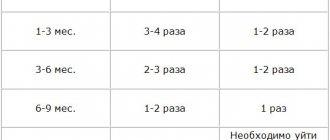Mother's milk is the most valuable product for newly born babies. But situations arise when, for medical reasons, a woman cannot breastfeed, or she has no milk at all. Then artificial feeding of newborns is used, which is slightly different from breastfeeding.
Formula-fed baby
Daily routine for a child up to one year old: the need to establish
The introduction of the child into the regime should be carried out already in the first month of his life. In this case, it is necessary to take into account the peculiarities of the newborn period, which is characterized by a chaotic alternation of sleep and wakefulness. Daily routine for a baby up to a month old
(a newborn child) cannot yet be called a “regime” in essence. This is only the formation of a certain regime of a newborn child. The predominant reason for a child waking up in the first month of life is hunger excitement. The most appropriate way for a month-old baby to be awake immediately after feeding and sleep before the next feeding. As a rule, after waking up, the baby eats well, after which he remains awake, then quickly falls asleep and sleeps soundly until the next feeding. When following a feeding regimen, a child under one year of age develops a need to sleep and eat at certain hours, and the time of wakefulness gradually increases during the day, and the time of sleep in the evening and at night. Often, a child’s bad mood is associated precisely with a violation of the daily routine, which leads to overwork and lack of sleep, which subsequently affects his physical and mental health: the child develops poorly and becomes irritable. Children living according to the established regime do not need additional reassurance (rocking, carrying in arms, using a pacifier). If the baby lives according to a certain regime, he will easily get used to the daily routine in kindergarten. Children in their first year of life usually sleep soundly at night. If they are restless, you need to find out the reason. There is no need to rush to feed your baby. Maybe diapers need changing or a change in position, maybe mosquitoes or other insects are bothering you, or the baby is hot or cold. It is important to eliminate the causes of crying. Infants fall asleep very quickly if their parents rock them in their arms, in a stroller or crib. But sleep during motion sickness is shallow, and the child can quickly wake up. In addition, a certain habit of motion sickness arises. It is also undesirable to use a pacifier, as it interferes with the onset of deep sleep and contributes to the development of a negative habit. During the first year of life, the child’s routine should change 4 times. Transfer to each subsequent regimen should be carried out only on the recommendation of a pediatrician.
Nutritional Features
The forced measure of transferring a child to artificial feeding is carried out strictly under the supervision of a pediatrician. If the mother is still in the prenatal center, the baby is fed donor milk for the first 2-3 days. After being discharged home, the woman will have to constantly prepare a fresh mixture based on adapted products.
Additional Information. The composition of the mixture is as close as possible to breast milk in terms of the quantitative content of carbohydrates, proteins, fats and other nutrients. The product contains at least 15 different vitamins and 11 micro- and macrocomponents.
Modern mixtures are produced in categories for:
- children born healthy;
- low birth weight and premature babies;
- prone to allergies.
For each period of newborns, their own mixtures are selected (from the first days to a month, up to 3, 6, 12 months). Therefore, it is necessary to start artificial nutrition strictly with the starting product.
Adapted infant formulas
When feeding a baby with formula from birth, it is important to properly organize high-quality nutrition. If you do not follow the rules and regimen, there are risks of both overfeeding and underfeeding the baby. Therefore, it is advisable to weigh newborns in the first months of life at least 2 times a week.
If there is a delay in body weight for more than 10 days, a change in diet will be required: switching to another mixture, introducing curds, prescribing fish oil. Controlling weight gain includes calculating calorie intake, daily and single volumes of formula, taking into account the baby’s life expectancy.
Child's daily routine: how to establish a child's daily routine
It would seem such an easy question: how to establish a child’s daily routine? But the answer to it is quite difficult. To establish a daily routine for a child under one year old, certain rules must be followed daily: the child must sleep, eat, and have fun at a certain time.
In order to ensure restful sleep and wakefulness (up to 4-5 weeks), you should establish only the correct feeding rhythm, that is, feed the baby at the same time, at regular intervals. During the first month, it is quite difficult to achieve any specific daily routine for a month-old baby. Newborn baby's daily routine
depends on food needs.
The need for food in babies arises depending on individual satiety: the baby can suck more or less milk, and therefore the interval between feedings varies significantly from 2.5 to 4.5 hours. Gradually, the baby will develop “his own” specific daily routine for a newborn child. With orderly feeding, the need for food arises at certain hours, and around the beginning of the second month, the child usually wakes up on his own at the time of feeding. Gradually, after feeding, calm wakefulness begins to arise. The periods of wakefulness become longer (from 40 minutes to 1 hour), and sleep becomes deeper. From about 4-6 weeks, children should develop a rhythm of wakefulness and sleep. In order for a child to be actively awake from the end of the first month, frequent communication from adults, the presence of toys and freedom of movement are necessary. For children of this age, the best condition for falling asleep quickly and deep sleep is sleeping in the fresh air. The age at which a child should be taken out into the fresh air depends on his health, season, and climatic conditions. In autumn, winter and early spring, you should gradually accustom your child to fresh air: take him to bed at the time established in the regime, first for a short time, and then for all periods of daytime sleep. It is especially important to sleep in the fresh air at this age, when the child is first accustomed to a daily routine. If, from the end of the child’s first to the beginning of the second month, the correct daily routine is systematically followed, then by 3 months the child can completely live according to a certain regimen. If the baby cries before the established feeding hours, he should be fed. If he cannot get used to the established regime for a long time, another one should be prescribed that meets his needs. For newborn children under the age of 3 months, the most correct daily regimen
is to feed the child 7 times a day, with a period of wakefulness initially of 1 hour, and by 3 months - 1.5 hours and daytime sleep 4 times for 2-2.5 hours and at night from 11 to 10 o'clock. Bathing is a good way to strengthen a small child's night sleep.
Parents themselves must set bathing hours that are convenient for them, after which the child will sleep well. Depending on the child’s condition and specific household conditions, for the convenience of the mother, the hours in the daily routine of a child up to one year old
can be moved, and the hours of all routine moments are shifted accordingly.
When healthy, normally developing children up to 5-6 months are raised on a regimen with 3-hour breaks between feedings instead of switching from 2.5-3 months to 6 feedings a day with breaks of 3.5 hours, they will instead of 2 hours, they continue to stay awake for 1.5 hours. At the same time, by the time the child goes to bed, the need for rest has not yet arisen; he does not fall asleep for a long time. Therefore, if a child of 2.5-3 months is already easily awake for 1.5 hours, he needs to be transferred to the next day of the child up to a year. Gradually, the period of wakefulness increases, so the baby should be put to bed not 1.5 hours after waking up, but a little later, when the first signs of fatigue appear. Until 4-5 months, the child continues to sleep 4 times during the day. Some children do not sleep 4 times during the day, in this case they are put to bed earlier at night, then the duration of night sleep increases to 11 hours. From about 5-6 months, the baby needs to be switched to the daily routine for a 6-month-old child
, in which the duration of active wakefulness is 2-2.5 hours.
During the day, children already sleep 3 times for 2-2.5 hours. The duration of night sleep is 10-11 hours. The number of feedings is 5. At the age of 9-12 months, the baby is transferred to a daily routine with two naps during the day. In this daily regimen, the duration of periods of wakefulness ranges from 2.5 to 3.5 hours. The duration of the first segment of daytime sleep increases to 2.5 hours, the second time the baby sleeps for 1.5-2 hours. Night sleep lasts 11 hours. The baby is fed 4-5 times a day. When switching to a daily routine for a child up to one year old
with double naps during the day, it is not possible to maintain equal breaks between feedings.
The interval in food intake between the first and second feedings, as well as between the second and third, reaches 4.5 hours. Such a length of intervals between feedings is acceptable because during this period of time the baby is not only awake, but also asleep. The break between the third and fourth feeding, when the baby is awake, is reduced to 3-3.5 hours.
How to determine the amount of formula based on the baby's weight. Table of proportions
The amount of formula for a newborn by month can be calculated depending on the weight of the child.
Approximate proportions (by caloric intake) for expected and actual weight:
| Age | Joules (kJ/kg) | Calories (kCal/kg) |
| 0-3 months | 500 | 118-120 |
| 4-6 months | 470 | 113-115 |
| 7-9 months | 450 | 107-110 |
| 10-12 months | 430 | 100-105 |
Using the Finkelstein formula, the daily norm can be found in several ways:
- the child’s age (number of days) is multiplied by 70 (if the child’s weight does not exceed 3200 g);
- age (number of days) is multiplied by 80 (if the child’s weight exceeds 3200 g).
To calculate the daily intake of formula using the Reich formula, you need to divide the child’s weight by his height. The resulting value is multiplied by 70.
Approximate daily routine for children aged 1 to 3 months
1st
option
| 2nd option | |||
| 1st feeding | 6.00 | 1st feeding | 6.00 |
| Wakefulness | 6.00-7.00 | Wakefulness | 6.00-7.00 |
| Dream | 7.00-9.00 | Dream | 7.00 -9.30 |
| 2nd feeding | 9.00 | 2nd feeding | 9.30 |
| Wakefulness | 9.00-10.00 | Wakefulness | 9.30-10.30 |
| Dream | 10.00-12.00 | Dream | 10.30 -13.00 |
| 3rd feeding | 12.00 | 3rd feeding | 13.00 |
| Wakefulness | 12.00-13.00 | Wakefulness | 13.00-14.00 |
| Dream | 13.00-15.00 | Dream | 14.00 -16.30 |
| 4th feeding | 15.00 | 4th feeding | 16.30 |
| Wakefulness | 15.00-16.00 | Wakefulness | 16.30-17.30 |
| Dream | 16.00-18.00 | Dream | 17.30 -19.45 |
| 5th feeding | 18.00 | Bathing | 19.45 |
| Wakefulness | 18.00-19.00 | 5th feeding | 20.00 |
| Dream | 19.00 -20.45 | Wakefulness | 20.00-21.00 |
| Bathing | 20.45 | Night sleep | 21.00-6.00 |
| 6th feeding | 21.00 | 6th night feeding | 23.30 (or 2.00) |
| Night sleep | 21.00-6.00 | ||
| 7th night feeding | 24.00 (or 3.00) | ||
Formula dosage for newborns
Acne in newborns - what is it?
Although the formulas are adapted for breast milk, they still have a slightly different ratio of proteins, carbohydrates and fats. Therefore, the calorie content of food consumed during IV is 10-15% higher. However, the single volume of liquid given to the baby increases slightly, but the daily amount remains the same as with breastfeeding.
The dosage of the formula for newborns per appointment is selected taking into account the age of the baby. Daily calorie content is calculated based on the type of mixture (i.e., carefully study the manufacturer’s information printed on the packaging).
Instructions on the package
The preparation instructions contain a table showing how to properly dilute baby powder and in what quantity for a certain age. Each child has different needs. One baby may eat more than the recommended portion, another – less. Here the mother herself selects the optimal dose for her little one.
Important! If the baby has eaten less than what was prepared for him, he should not be forced to finish the milk formula. Perhaps he ate a little more last time.
Leftover food does not need to be left until the next feeding (even if it is stored in the refrigerator). It’s better to prepare a fresh mixture the next time.
Approximate daily routine for children aged 2.5-3 to 5-6 months
| 1st feeding | 6.00 |
| Wakefulness | 6.00 — 7.30 |
| Dream | 7.30 — 9.30 |
| 2nd feeding | 9.30 |
| Wakefulness | 9.30 — 11.00 |
| Dream | 11.00 — 13.00 |
| 3rd feeding | 13.00 |
| Wakefulness | 13.00 — 14.30 |
| Dream | 14.30 — 16.30 |
How long does it take for a baby to digest formula?
Artificial feeding of newborns cannot be organized on a sliding schedule. The main point that should be taken into account with IV is how long the infant digests the mixture.
For babies in the first weeks of life, the digestive process of a heavier product than human milk takes 3.5 hours, for children over 5 months – 4 hours. Therefore, if the baby behaves restlessly and cries between meals, it is not because he is hungry. Perhaps he simply cannot go to the toilet and his tummy is bloated.
Approximate daily routine for children aged 5-6 to 9-10 months
| 1st feeding | 7.00 |
| Wakefulness | 7.00-9.00 |
| Dream | 9.00-11.00 |
| 2nd feeding | 11.00 |
| Wakefulness | 11.00-13.00 |
| Dream | 13.00-15.00 |
| 3rd feeding | 15.00 |
| Wakefulness | 15.00-17.00 |
| Dream | 17.00-19.00 |
| 4th feeding | 19.00 |
| Wakefulness | 19.00-21.00 |
| Bathing | 20.30 |
| Night sleep | 21.00-7.00 |
| 5th night feeding | 23.00 |
General rules for artificial feeding
White noise for newborns
In order for the baby to adapt comfortably, it is important to adhere to general principles. When feeding a newborn with formula from birth, the basic rules include the following:
- Bottles and nipples are sterilized before each feeding and stored in a closed container. After use, wash immediately.
- The mixture is prepared immediately before use, maintaining a temperature of 37-40°.
Preparing fresh mixture
- It is necessary to adhere to the duration of normal feeding within 15-20 minutes. Therefore, make sure that baby fluid flows out of the nipple in drops and not in a trickle.
- Accustoming to IV occurs gradually; only one type of adapted mixture is used.
- If the child is unable to gain weight as a result, the product is also replaced gradually, over 2-3 days.
Important! Timely adjustments in feeding will prevent the development of hypertrophy in the baby.
- The first complementary foods for IV children are introduced 3-4 weeks earlier than for “straight” children.
With artificial nutrition, babies receive more protein than those on breastfeeding. Therefore, they will need additional drink in the amount of 80-100 milliliters per day (boiled water, weakly brewed tea, rose hip decoction).










